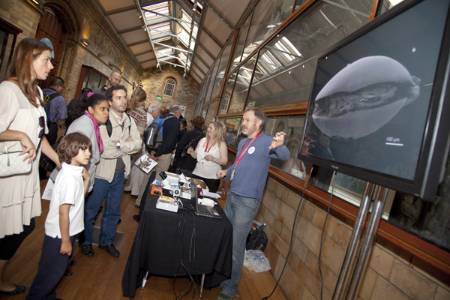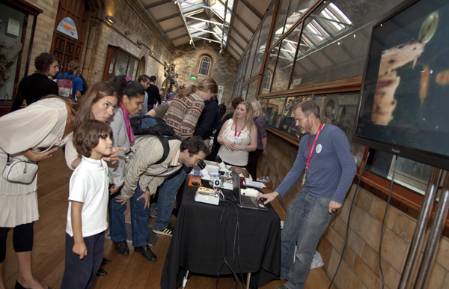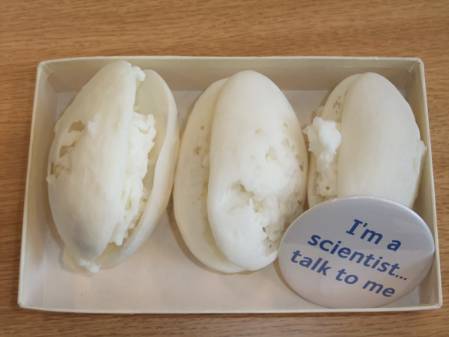I have lost track of the number of times I have explained to people what I do and they have replied that they had no idea that this type of work was going on behind the scenes at the Natural History Museum. On Friday 23rd September it was our chance to take centre stage in the galleries in Science Uncovered, the largest 'show and tell' the Museum has ever put on.
Using a large plasma screen to bring tiny fossils to life (Photo by Kevin Webb and copyright Natural History Museum)
Explaining about microfossils can be a difficult task considering their size and relative unpopularity compared to the dinosaurs and early human fossils that were being displayed on the tables less than 10 metres away. I have previously taken part in science communication events like these and found that microscopes have been a big draw to get the crowds in. This time at Science Uncovered, I found that a large plasma screen showing some eye catching videos and images were more a effective communication tool than ever before. Members of the public were drawn towards the screen to see what I had to say about my subject.
Showing a video of a living ostracod on the giant plasma screen (Photo by Kevin Webb and copyright Natural History Museum)
I won't say too much at the moment about what I was talking about other than I was introducing some recent studies on some of our most important ostracod collections. I intend to make that research project the subject of a future blog entitled 'What microfossils tell us about sex in the Cretaceous'.
The important theme to this evening was to show the relevance of our collections and research to every day life and showcase to members of the public our science. The ostracods I showed are vital to exploration offshore Brazil and West Africa in areas where oil is being found. Knowledge of the reproductive strategies of ostracods is also vital to interpreting, not just the modern day distribution of ostracods but also the fossil record. Ostracods can give detailed information about past environments (see the Ockley dinosaur blog) and are increasingly being used to interpret past climates.
A video of the living ostracod Eucypris virens. This is related to the fossil examples that I was showing. (Video courtesy of Dave Horne, Queen Mary College, University of London)
It is quite tiring speaking about your subject non-stop for any period of time and my voice was quite dry after an hour. I remember taking part in a similar public event entitled the 'Fossil Road Show' back in the late 1990s and losing my voice completely by the end of the day. Fortunately this time we were using a rota system that changed the staff and specimens on the Palaeontology Station every hour. After my hour was finished I was quite disappointed to be stopping and wished that I could have carried on for longer.
Another minor disappointment was that I did not see other aspects of the event and get the chance to fully see what my colleagues from around the museum had to say.
Some scale models of the Cretaceous ostracod Harbinia micropapillosa and my badge.
I do have one momento from the event; a badge with 'I'm a scientist.... talk to me'. Guardian journalist Camila Rus joked that some Museum staff had intended to wear their badges on their commute to and from work. I'm not sure this would work considering the almost complete lack of action of fellow passengers when my Natasha wore her 'Please give up your seat, I'm pregnant' badge. What I do know is that large plasma screen was an enormous help to me at 'Science Uncovered' and made my job of explaining my science much easier.





